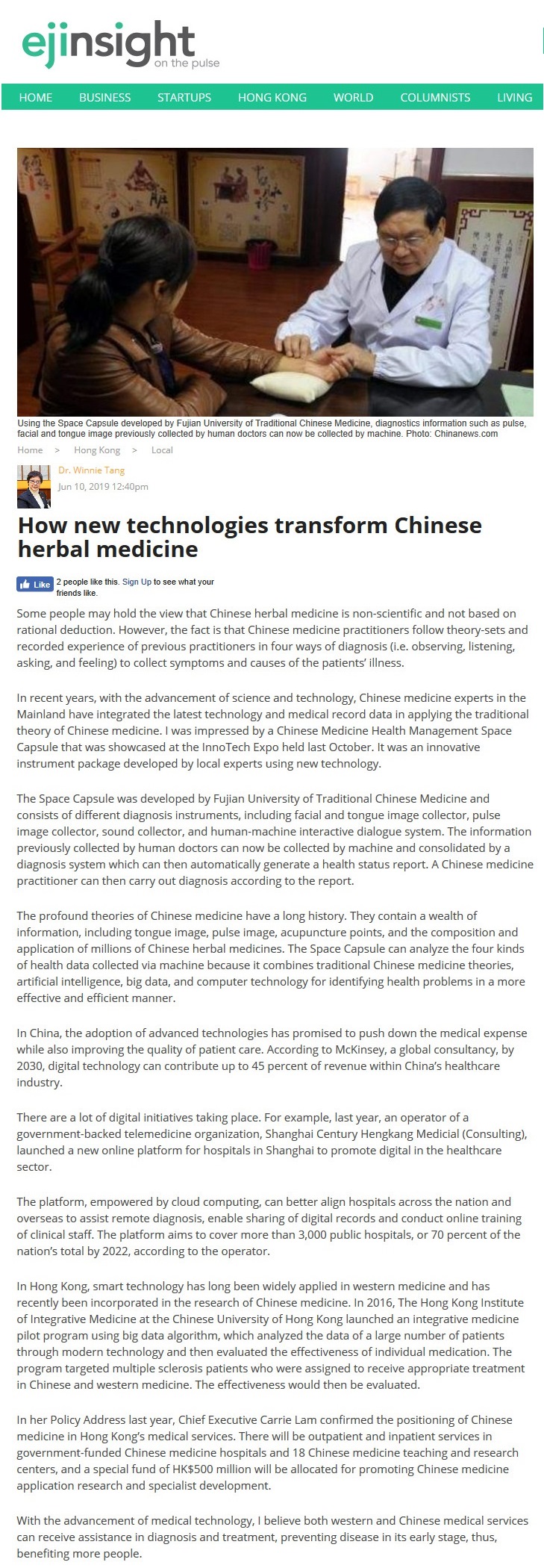網上版請按此

How new technologies transform Chinese herbal medicine
Some people may hold the view that Chinese herbal medicine is non-scientific and not based on rational deduction. However, the fact is that Chinese medicine practitioners follow theory-sets and recorded experience of previous practitioners in four ways of diagnosis (i.e. observing, listening, asking, and feeling) to collect symptoms and causes of the patients' illness.
In recent years, with the advancement of science and technology, Chinese medicine experts in the Mainland have integrated the latest technology and medical record data in applying the traditional theory of Chinese medicine. I was impressed by a Chinese Medicine Health Management Space Capsule that was showcased at the InnoTech Expo held last October. It was an innovative instrument package developed by local experts using new technology.
The Space Capsule was developed by Fujian University of Traditional Chinese Medicine and consists of different diagnosis instruments, including facial and tongue image collector, pulse image collector, sound collector, and human-machine interactive dialogue system. The information previously collected by human doctors can now be collected by machine and consolidated by a diagnosis system which can then automatically generate a health status report. A Chinese medicine practitioner can then carry out diagnosis according to the report.
The profound theories of Chinese medicine have a long history. They contain a wealth of information, including tongue image, pulse image, acupuncture points, and the composition and application of millions of Chinese herbal medicines. The Space Capsule can analyze the four kinds of health data collected via machine because it combines traditional Chinese medicine theories, artificial intelligence, big data, and computer technology for identifying health problems in a more effective and efficient manner.
In China, the adoption of advanced technologies has promised to push down the medical expense while also improving the quality of patient care. According to McKinsey, a global consultancy, by 2030, digital technology can contribute up to 45 percent of revenue within China's healthcare industry.
There are a lot of digital initiatives taking place. For example, last year, an operator of a government-backed telemedicine organization, Shanghai Century Hengkang Medicial (Consulting), launched a new online platform for hospitals in Shanghai to promote digital in the healthcare sector.
The platform, empowered by cloud computing, can better align hospitals across the nation and overseas to assist remote diagnosis, enable sharing of digital records and conduct online training of clinical staff. The platform aims to cover more than 3,000 public hospitals, or 70 percent of the nation's total by 2022, according to the operator.
In Hong Kong, smart technology has long been widely applied in western medicine and has recently been incorporated in the research of Chinese medicine. In 2016, The Hong Kong Institute of Integrative Medicine at the Chinese University of Hong Kong launched an integrative medicine pilot program using big data algorithm, which analyzed the data of a large number of patients through modern technology and then evaluated the effectiveness of individual medication. The program targeted multiple sclerosis patients who were assigned to receive appropriate treatment in Chinese and western medicine. The effectiveness would then be evaluated.
In her Policy Address last year, Chief Executive Carrie Lam confirmed the positioning of Chinese medicine in Hong Kong’s medical services. There will be outpatient and inpatient services in government-funded Chinese medicine hospitals and 18 Chinese medicine teaching and research centers, and a special fund of HK$500 million will be allocated for promoting Chinese medicine application research and specialist development.
With the advancement of medical technology, I believe both western and Chinese medical services can receive assistance in diagnosis and treatment, preventing disease in its early stage, thus, benefiting more people.
Dr. Winnie Tang
Adjunct Professor, Department of Computer Science, Faculty of Engineering and Faculty of Architecture, The University of Hong Kong